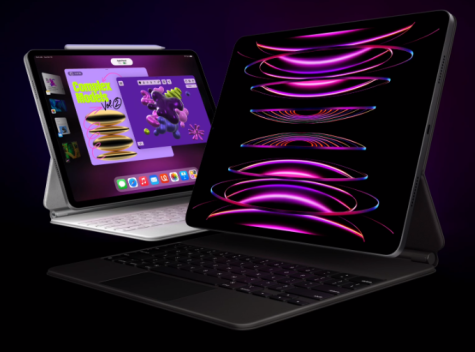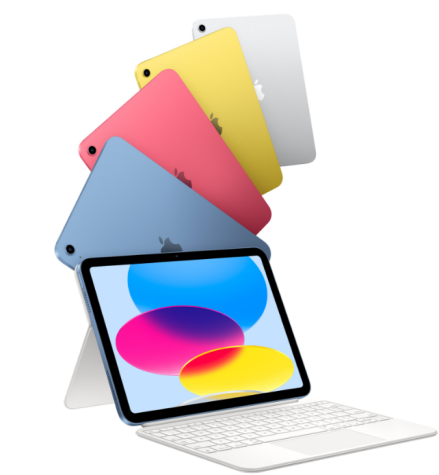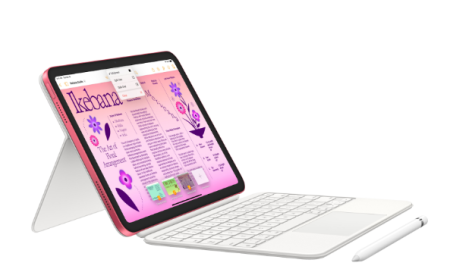The State of Apple’s iPad Lineup
Is there anything more than can be done to the iPad?

https://www.youtube.com/watch?v=yUKRkPKg5_U
November 1, 2022
On Tuesday, October 18, Apple released a new 10th Generation iPad and a new iPad Pro. This was not a big event like previous years but rather was a press release with a short 10-minute video being posted online. This is most likely due to the fact that the iPadOS 16 release was pushed back multiple times so they just wanted to get these hardware products and software upgrades out there. Both of the new iPad’s have some questionable features and design choices while putting a stir in the lineup as a whole. Here is everything you need to know about the new 10th Generation iPad and iPad Pro.

https://www.apple.com/ipad-pro/
Starting with the iPad Pro, the main change is internal. It features the new M2 chip making everything much faster. From video editing to gaming and even 3D design, the M2 chip handles these programs with ease. The new Media Engine and Image Signal Processor (ISP) in M2 allow for ProRes capture for the first time on iPad. It can now connect to WiFi 6E making ProRes file transfers extremely fast. Now comes the confusing part. With the power of M2, the new iPad Pro can detect the Apple Pencil in three dimensions up to 12 millimeters away. This allows for more creative control, faster Scribble, and more intuitive features. With that being said, users are already seeing evidence that older iPads can use this feature. Some people are seeing aspects of Apple Pencil Hover when using Sidecar and when some Accessibility settings are active.

https://www.apple.com/ipad-pro/
Does this mean that Apple Pencil Hover will come to older iPads too? At this moment it is still unknown. However, with the information that is put out, it seems like Apple Pencil Hover is a software-locked feature used to help sell the new iPads. The Apple Pencil looks to remain unchanged and there was no mention of any new screen technology in the iPad Pro. The fact that there is evidence of this new feature on older iPads leads to the theory that Apple is running out of ways to upgrade the iPad. The new iPad Pro is still a great device for people who will take advantage of the performance it has to offer, but you are still running the mobile version of most apps on iPadOS 16. That means really leveraging the power of M2 is a bit harder to do. Is it worth the upgrade if you have last year’s iPad Pro or even the one from the year before? I would say no. Unless you are really going to leverage the power of the M2 chip or the Apple Pencil, all you are getting in this upgrade is a new generation number.

https://www.apple.com/ipad-10.9/
The 10th Generation iPad is probably the most confusing part of the refreshed lineup. It falls between the 9th Generation iPad (which is still a part of the lineup) and the iPad Mini. It comes in Silver, Pink, Blue, and Yellow. The screen is now 10.9” (compared to the 10.2” on the 9th Generation), has a 12MP camera, and has an A14 Bionic chip. It now charges over USB-C and has 5G on cellular models. The 10th Generation iPad looks like the iPad Air but is missing some of its features. While the Touch ID in the power button remains, it does not have support for the second-generation Apple Pencil and the Smart Connector for the keyboards has moved to the bottom edge. These two “features” are what make this iPad so confusing.

https://www.apple.com/ipad-10.9/
The main reason why the second-generation Apple Pencil moved is that the front-facing camera is now on the horizontal edge, taking up space where the Apple Pencil charger would be. The only odd part about this change is that the iPad Pro’s front-facing camera and Face ID sensor suite remain in the same place. Regardless of the reasoning behind this, the first-generation Apple Pencil is now the only Apple Pencil compatible with the new iPad. However, it was originally designed for iPad models with Lightning, not USB-C. This means to charge it off the new iPad, you need an adapter, which is now included in the box. This annoying design choice is quite confusing. While it does help to split up the lineup, it is nothing like what they decided to do with the Smart Connector.

https://www.apple.com/ipad-10.9/
On the 10th Generation iPad, the Smart Connector has moved to the bottom. This would be a sensible design change if they also applied it to the new iPad Pro, but they didn’t. Because of this, there is only one official keyboard option which costs a ridiculous $250. This is $50 short of the floating version keyboard (which is incompatible) and $90 more than the entry level version (also incompatible). It is also the only keyboard in Apple’s lineup that does not work across other iPad models. The only color the keyboard is available in is White, which is prone to stains and discoloration. If you add on the keyboard, it brings the total price to $698, which is almost $100 more than the iPad Air. So for less, you could get support for the second generation Apple Pencil, the power of the M1 chip, and more options for keyboard accessories.
From the looks of things, none of the new iPads are a worthy upgrade. They either have unlocked software features or absurdly expensive hardware which does not make sense. The iPad Pro is more powerful, sure, but for the price of a new MacBook Air (depending on the spec) is it worth running mobile versions of apps? The fact that the 9th Generation iPad is still in the lineup means Apple isn’t even sure if the 10th Generation iPad will sell. So then why keep it in the lineup at all? These questions will probably never be answered and people are still going to buy them regardless of how much the lineup is now disrupted. Are you going to buy the 10th Generation or the new iPad Pro or are the updates too minor?


